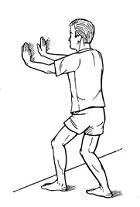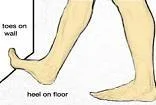Heel Disorders and Treatments (Plantar Fasciitis)
Relief for Painful, Inflamed Heels
Sharp pain, aching or stiffness on the bottom of one or both heels is a very common ailment. The pain is often at its worst upon awakening in the morning (or after sitting down for an extended period and then resuming activity), causing hobbling or limping for a few minutes before a comfortable stride can be resumed. As weight continues to be applied during walking or standing, mild or severe pain may persist.
Causes of Heel Pain

Several layers of fatty tissue surround the heel bone, softening the impact or walking and running and protecting the bones and muscles of the foot. Beneath this padding, a fibrous band of connective tissue (the fascia) extends from the heel bone, supports the arch and reaches across to the toes. Pain can result when these tissues become irritated or inflamed, or when small spurs grow on the heel bone.

You should also freeze a bottle of water and roll your arch over the frozen bottle for 5-10 minutes twice a day to decrease inflammation to the plantar fascia.
Massage the plantar fascia 2-3 times daily

Inflammation Most cases of heel pain are characterized by inflammation. First, the fascia begins to pull on the bone and the tissues become irritated, then inflamed. Inflammation of the fascia is called fascitis. Heel Spurs A projection or growth of bone may be called a spur, and can grow where the muscles of the foot attach to bone. Most spurs are non-painful and do not require surgical removal. Nonsurgical Medical Treatments If self-care measures do not relieve the pain, the podiatric surgeon may recommend various treatments to reduce inflammation. Some of these may include:
Prescription oral nonsteroidal anti-inflammatory medications to reduce both pain and inflammation. Cortisone injections & Physical therapy - The podiatrist or physical therapist may treat heel pain with ultrasound, electrical stimulation or hydrotherapy. Each of these methods may help reduce inflammation. Custom orthotics - A foam or plastic orthotic (custom-made to fit the foot) can often relieve the strain on the tissues and permit the heel to recover.